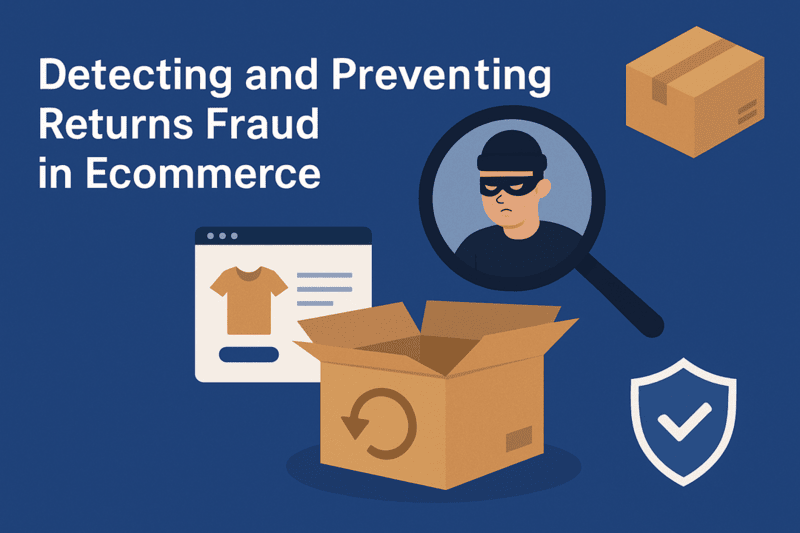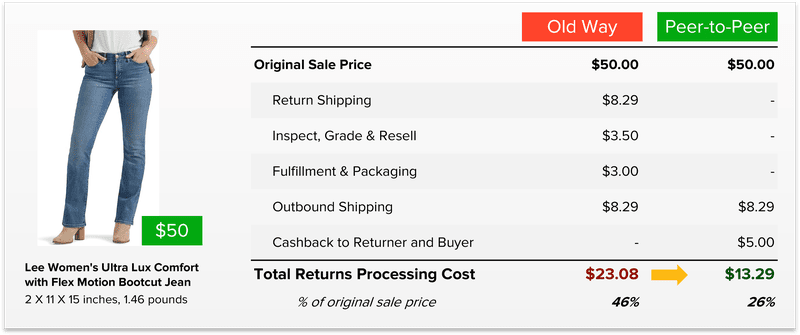Detecting and Preventing Ecommerce Returns Fraud (Step-by-Step)

Last updated on April 25, 2025

Returns are a crucial aspect of the ecommerce experience, but returns fraud has become an increasing threat to online retailers. From refund fraud to return abuse, these fraudulent activities can severely impact profit margins, undermine customer trust, and hurt a business’s bottom line. Detecting and preventing return fraud is essential for protecting your ecommerce operation and maintaining long-term success.
What Is Returns Fraud?
Returns fraud refers to any action a customer or individual takes to exploit the return process for personal gain. It can involve a variety of methods, from returning stolen merchandise for a refund to switching the items inside the box or using altered receipts. These practices not only hurt ecommerce merchants financially but also undermine the customer experience and increase operational costs.
As ecommerce sales continue to rise, fraud is a growing concern. According to the National Retail Federation, return fraud costs retailers hundreds of billions of dollars every year. For online retailers, the financial impact can be even more severe due to the lack of physical contact with customers, making it easier for fraudulent behavior to go unnoticed.
Common Types of Returns Fraud
Understanding the different types of return fraud is the first step in detecting it. Here are the most common fraudulent return schemes that ecommerce merchants should be aware of:
1. Friendly Fraud
- Definition: Friendly fraud, also known as chargeback fraud, occurs when a customer falsely claims they never received their order or that the item was damaged or defective, despite no issue with the product.
- Impact: It leads to the merchant being forced to provide a refund, potentially losing both the product and the revenue from the sale.
2. Serial Returners
- Definition: These are customers who continuously return items without valid reasons, often after using or damaging the products. They may try to manipulate the system by frequently exploiting the return window.
- Impact: This abuse of the return policy leads to financial losses and strains the company’s ability to manage inventory efficiently.
3. Receipt Fraud
- Definition: This involves customers returning items without receipts or with altered receipts. Some fraudsters even use fake receipts to claim refunds for products they never purchased.
- Impact: This type of fraud not only costs money but also complicates the return process for legitimate customers.
4. Box Fraud
- Definition: A more elaborate scheme involves customers returning an empty box or a different, less valuable item in place of the purchased merchandise.
- Impact: Ecommerce merchants can lose a product without ever realizing it, leading to significant profit losses.
5. Stolen Merchandise Returns
- Definition: Fraudsters often return stolen merchandise for a refund or store credit, sometimes through a third-party retailer to avoid detection.
- Impact: Retailers are left with no product and a loss of funds while fraudsters benefit from illegal profits.
How to Detect Returns Fraud
Detecting return fraud is essential to mitigating losses and ensuring that your returns process isn’t facilitating fraudulent returns. Here are key strategies to help ecommerce merchants identify fraud:
1. Monitor Customer Return History
- By analyzing customer return history, you can spot unusual patterns such as frequent returns from the same account, excessive returns of high-value items, or returns made outside the return window.
- Tools like fraud detection software and machine learning algorithms can help flag customers who repeatedly abuse the system.
2. Identify Fraudulent Return Patterns
- Frequent Returns: If a customer returns items frequently, especially those from the same category or brand, it could signal fraudulent activity.
- Return of High-Value Items: Items with a higher price tag are more likely to be targeted by fraudsters. Track returns of high-ticket items more closely.
- Unusual Return Method: Customers who always return items via online portals or ship back returns in non-original packaging may be attempting to game the system.
- Empty Box Fraud: One of the clearest signs of fraud is when a returned item doesn’t match the product in the original order.
3. Use Advanced Technologies to Detect Fraud
- Machine Learning and AI: Advanced tools can learn what “normal” return behavior looks like and alert you when an account shows signs of suspicious activity.
- Transaction Data: Cross-referencing transaction data with return data—such as shipping address, payment method, and item categories—may reveal discrepancies.
4. Cross-Retailer Return Fraud
- Challenge: Fraudsters may attempt to return the same item to multiple retailers.
- Solution: Build data-sharing and cross-checking systems to compare returns across merchants for high-value items.
Step-by-Step Guide to Preventing Returns Fraud
Once you’ve detected fraud patterns, implement these strategies to prevent future fraudulent returns:
1. Establish a Clear Return Policy
- A strong, transparent return policy is your first line of defense. Clearly state the return window, conditions for returns, and the need for proof of purchase. Ensure customers understand the consequences of fraudulent returns.
- Consider offering store credit instead of refunds for returns made outside the policy window.
2. Use Digital Tracking and Verification
- Leverage digital tracking tools to ensure that returned merchandise matches the original product. Implementing serial-number tracking or unique identifiers on high-value items can help deter fraud.
- Verify returns through online portals and inspect product condition before issuing refunds.
3. Implement Restocking Fees
- To discourage serial returners, implement a restocking fee—especially on high-demand or high-value items—to deter “try and return” abuse.
4. Leverage AI and Fraud Detection Software
- Invest in solutions like Signifyd or Forter that use machine learning to flag high-risk returns before they’re processed.
- Building customer loyalty helps reduce return fraud by rewarding legitimate customers and discouraging fraudulent return activities. Loyal customers are more likely to follow return policies, while fraudulent customers are deterred by loyalty programs and stricter return rules.
- Educate staff to identify red flags—suspicious return requests, lack of receipts, or patterns of collusion—for early intervention.
5. Monitor Customer Loyalty and Return Behavior
6. Train Employees to Spot Fraud
Case Study: Successful Fraud Prevention in Ecommerce
One retailer implemented a machine-learning fraud detection system to track return patterns and cross-reference purchase data. As a result, fraudulent returns decreased by 40% within the first year, while restocking fees and store-credit policies further protected margins and maintained customer loyalty.
Conclusion
Returns fraud is a significant challenge but can be mitigated with clear policies, advanced detection tools, and proactive monitoring. Early detection and prevention protect margins, foster loyalty, and ensure a positive customer experience.
Frequently Asked Questions
What are the most common types of ecommerce returns fraud?
The most common types of return fraud include friendly fraud, serial returners, stolen merchandise returns, box fraud, and receipt fraud. These methods can lead to significant financial losses for ecommerce businesses.
How can ecommerce merchants prevent return fraud?
Ecommerce merchants can prevent return fraud by implementing clear policies (and enforcing them), using fraud detection software, tracking transaction data, and offering store credit instead of refunds for suspicious returns.
How does machine learning help detect return fraud?
Machine learning analyzes customer transaction and return data to identify patterns and flag suspicious activity, enabling fraud prevention before losses occur.
Can fraud detection software help reduce return abuse?
Yes. Fraud detection tools can flag high-risk returns based on factors like return frequency, item category, and customer history, significantly reducing abuse.
What role does customer loyalty play in preventing return fraud?
Building customer loyalty helps reduce return fraud by rewarding legitimate customers and discouraging fraudulent return activities. Loyal customers are more likely to follow return policies, while fraudulent customers are deterred by loyalty programs and stricter return rules.

Up to 64% Lower Returns Processing Cost


 7 minutes
7 minutes